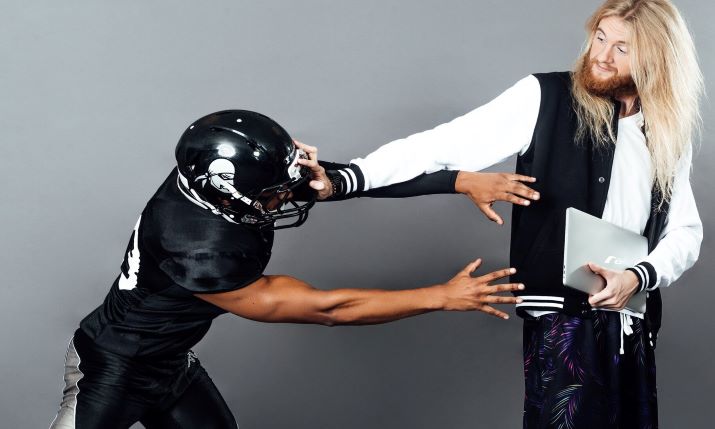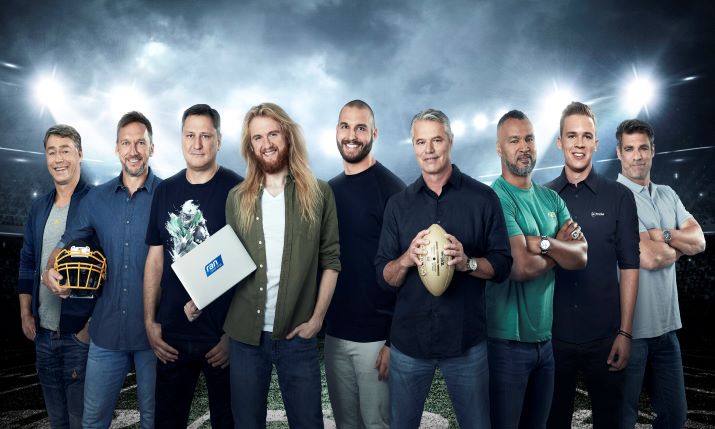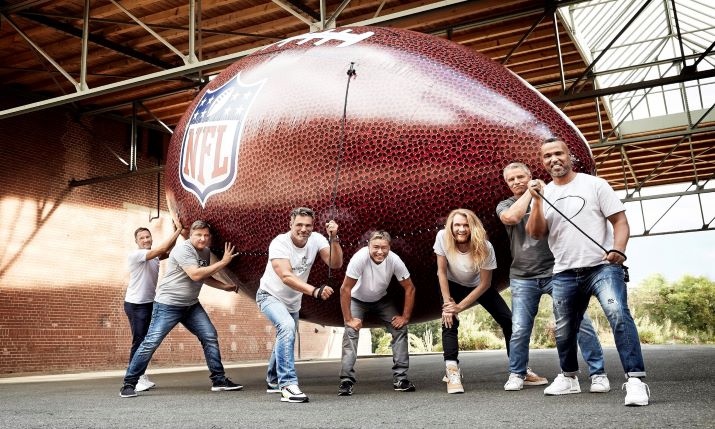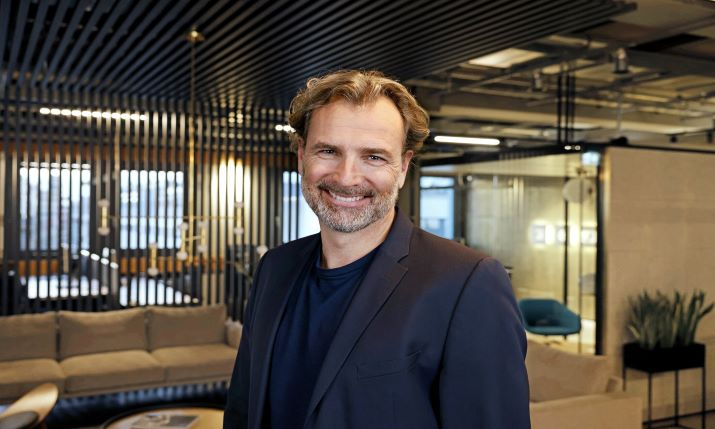Addicted to American football: ProSieben uncovers how to build a fanbase with #ranNFLsüchtig

Net Man: Christoph ‘Icke’ Dommisch. Since the 2015 NFL season , Dommisch has been ‘Net Man’ on ran’s NFL broadcasts and hosts Coach’s Corner together with Patrick Esume
With the emergence of the European League of Football (ELF), and the continued rise in interest in American football in Germany in particular, now is perfect timing to take a look at how German free-to-air networks ProSieben and ProSieben MAXX have driven popularity in the game, both through its broadcast strategy and by taking advantage of a social media phenomenon.
ProSieben, part of the ProSiebenSat.1 Media giant, has a long history with professional American football, first broadcasting the Super Bowl in 1999. That was combined with coverage of NFL Europe, the European League created by the NFL and featuring European teams.
According to Alexander Rösner, senior vice president of sports at Seven.One Sports, this was almost all produced and organised from the US by the NFL itself. “We broadcast the Super Bowl on Sunday nights, and a magazine show on Saturday nights,” he says. “That was our first experience with the NFL; it was pretty good, but it ended in 2003.”

Line up: The team covering the NFL for ProSieben MAXX, ProSieben and ran.de
Taking the next step
Seven.One Sports, the sports business unit of ProSiebenSat.1, took up the rights again in 2012 when ProSieben broadcast the Super Bowl, but after seeing the growing popularity of the game in Germany and identifying that its very keen fan community corresponded with the target demographic for the channel, it was decided to take things up a level.
“We said let’s take the next step, and broadcast a regular game for the whole season every Sunday,” recalls Rösner. “The discussion then was whether there were enough people in Germany willing to watch [as much as] two NFL games every Sunday.”
The NFL regular season begins in the second weekend in September and ends in late December or early January. Typically, the majority of each weeks’ games are played on Sunday afternoon. All playoff games and the Super Bowl take place on either Saturday or Sunday in January and early February. With the time difference, the NFL games broadcast in the US on a Sunday would playout at 7pm and around 10pm on a Sunday evening in Germany. The strategic decision was taken to go all in.
“We decided to broadcast a doubleheader every Sunday on our smaller male-oriented channel ProSieben MAXX,” says Rösner “It was a very risky decision, but [in the end] definitely the right one in order to build up a community and to start our story.”
Attracting the fans
“ProSieben MAXX on average has a market share of 1.7% in the target group aged 14 to 49,” says Rösner. “When we started broadcasting the doubleheaders in 2015, from the very beginning in both the early and the late slot we hit a market share of 2.7%; last season that number rose to 5.2%.”
To give that increase some perspective, this early slot is the most competitive on German TV. “Primetime on Sundays is the time when most people watch television in Germany,” Rösner says. “In total numbers, we expanded our reach from 280,000 viewers, on average, to 440,000 viewers every Sunday in both slots combined.
“Year by year our Super Bowl broadcasts deliver record-breaking TV ratings,” he adds. “2.23 million people on average watched Super Bowl LV last February on ProSieben till four in the morning, representing a market share of 58.4% in our target group of people aged 14 to 49. ”
So what’s the reason for this success? There are a number of factors, according to Rösner. “First of all, this sport is amazing. At the end of the day, it’s always the sport that is the reason for the success of a sports broadcast. [American] football is the most popular sport in the USA, and historically it had a small fanbase in Germany. But as special interest content, football was mostly broadcast on pay-TV channels with limited access, often in the middle of the night. It was not trendy back then. What we did was open the window and give this fantastic game a stage on free-to-air television.”
The games running on ProSieben MAXX come straight from the US broadcasters feed – Fox, NBC or CBS – provided by NFL Media, coming live via London.

For the NFL’s 2021 season ProSieben MAXX, ProSieben and ran.de broadcasts live games on free TV and in the free live stream, covering the preseason and the regular season to the playoffs and the Super Bowl. Pictured are the ran football team on ProSieben and ProSieben MAXX: [L to R] Volker Schenk, Roman Motzkus, Carsten Spengemann, Uwe Morawe, Christoph “Icke” Dommisch, Jan Stecker and Patrick Esume
Another factor is the length of the season — fairly short by European standards and the regular time slot.
“It always starts at the same time, on a Sunday where you don’t have many other sports” says Rösner. “This regular scheduling is something that people got used to very fast, they loved it and began to celebrate it as a fixed event within a fast-growing football community.”
The final big factor was a combination of this emerging community and the way that ProSieben decided to approach the broadcasts. “We did something brand new in Germany,” says Rösner. “We integrated the community into our live broadcasts.”
Break time
During each half of a US network-televised NFL game, there are nine prescribed commercial breaks following the official kickoff. Two are firmly scheduled, and seven others are worked in during breaks in the play.
“Previously [NFL coverage] always had the same problem in Germany,” says Rösner. “Due to German TV advertising regulations, not every US commercial break can be filled with ads – we’re only allowed to broadcast commercial breaks for 12 minutes per hour in Germany. And back then no-one was in a studio covering this.
“If you’re a viewer on pay-TV sitting at home, it’s late, you’re tired and then there are plenty of trailers, billboards and senseless clips during the breaks of that long broadcast. That’s not the right way to persuade people to watch and to love a sport.”
Instead Rösner’s team decided to do things differently. “We realised because of [American] football’s complexity we had to explain the rules to a bigger community than 30,000 hardcore fans, we had to show them that this is a fantastic sport, and at the same time we wanted to entertain the people,” he says. “We dedicated money to producing a studio zone where we could use the [many] breaks to get back to the studio, and explain the game to people, do tactical analysis, and last but not least use the time for interaction with the NFL community in front of the TV.”
The games are broadcast on ProSieben MAXX as ranNFL, and simultaneously the complete stream is on ran.de, the sports website of ProSiebenSat.1.
“The production side is different to other broadcasts, because normally – as when we cover the U21 Championship for example – we have a clean world feed. With the NFL , we get a dirty feed from US broadcasters with all their graphics and all of their commercial breaks,” says Rösner. “That’s one reason why we produce a studio show, because if they go to a break we have a black screen.
“The US broadcasters deliver a really amazing quality of signal so it’s good for us to have this feed, but it sort of complicates things from a production point of view; we need two guys running the show. One of them is guiding the commentator and the experts in the studio, and the other one needs to listen to the US line, in order to get to know what the US OB van is doing next. So we know if there’s a commercial break coming in five seconds, and we have to switch immediately to the studio.
“When we decided to broadcast two games in a row, it was seven hours programming, and with the magazine programme, it’s even more,” continues Rösner. “When we started, we had a half an hour highlight show before the kickoff, now it is sixty minutes. We found fantastic on-air talents, previously unknown people who are now famous TV and social media stars in Germany. [As well as] this constellation we let the viewers participate in our shows via social media.”
This was enabled by a ‘Net Man’ who was drawn from the editorial team. “He was very inside the game, not as a player, but as a fan, and now he’s our Net Man. People love him,” says Rösner “He’s on the computer, doing nothing else but communicating with [and for] the community, asking them questions, putting their questions to our commentator or experts. The football fans were sending pictures of how they watch the game and the show and then we brought them on air which made them feel like an important part of the show. That worked pretty well; the community grew and became bigger and bigger”
The #ranNFL hashtag, named after the website, started trending. “During the break after our second season the community, which is very interactive and very creative, missed football and the broadcasts so much, so they made up stories and produced videos at home, thousands of them, with the question “how do I realise that I am #ranNFLsüchtig?” Rösner recalls, adding that this hashtag incorporating the station web channel and the word süchtig, or ‘addicted’ in English, also started trending.
“They had so many funny stories, but we really took this seriously,” he adds. “We thought, how do we recognise the creativity of the community? So we honoured their involvement and their creativity by promoting the hashtag they used as the title of our show –#ranNFLsüchtig. We had to ask the NFL if we could use this name, but they loved the story, and agreed.”

Alexander Rösner, senior vice president of sports at Seven.One Sports
Game plan
The popularity of the coverage has grown year on year, and commercial bookings followed. “We have more commercials than in the past. Success means more breaks, which is good for our profits, but the way we broadcast is still the same,” says Rösner. “We still have our breaks in the studio without commercials.”
More success also meant the numbers were there for NFL to play out on the main channel ProSieben. “We do the Kickoff game and the Thanksgiving Late game on ProSieben, and since the last season three additional Regular Season games and all playoff games were broadcast on the big channel,” he adds. “We have amazing ratings, such as 20% market share on ProSieben for playoff games, and we are increasing the number of games on our flagship channel.”
The original platforms are also being developed further. “As well as the 60 minutes pregame show, we’ve got a weekly one hour web show on ran.de on Thursdays, to give a little pregame show before the weekend. We have amazing coverage of highlights on our website throughout the whole week” says Rösner. “And there is also an off-season magazine. As well as coverage of the NFL throughout the past season we can combine it with other US sports coverage.”
For the third year running, ProSieben MAXX has also broadcast NCAA College Football, the second tier of American football in the US and Canada. “We broadcast the early college game on Saturdays from six to ten which is also pretty successful. We have a market share of roundabout 2%, which is above the channel average of ProSieben MAXX, with roundabout 200,000 people watching it,” he says. “Next for us will be the newly founded European League of Football, which we will start to broadcast this June. It will give the growing community of American football fans another league.”
Keeping the fire burning
Plans are underway to repeat the success of the NFL coverage with this new league, which draws from teams in Germany, Poland and Spain. The ELF also has a close connection with ProSieben MAXX – regular ranNFL host and commentator Patrick Esume is one of the founders and the commissioner of the new league.
“It’s difficult, starting a new League, especially during the pandemic,” says Rösner. “So we don’t know exactly how it will look like at the end of the day, but we are programming the ELF games on Sunday afternoon, from three until six.
“So when the NFL starts and the ELF will play their semi-finals and finals, we will have a complete XXL football day on ProSieben MAXX.”
The ELF broadcast will finish at 6pm, then our #ranNFLsüchtig magazine will start.
“I’m very happy about the community and very happy about our people,” says Rösner. “Our fantastic crew is a big part of the story, and we really found the right people. There’s been an amazing reaction from the fanbase, but we have to feed them, to give them more sports and to keep that fire burning.”
The European League of Football starts in the summer of 2021.
